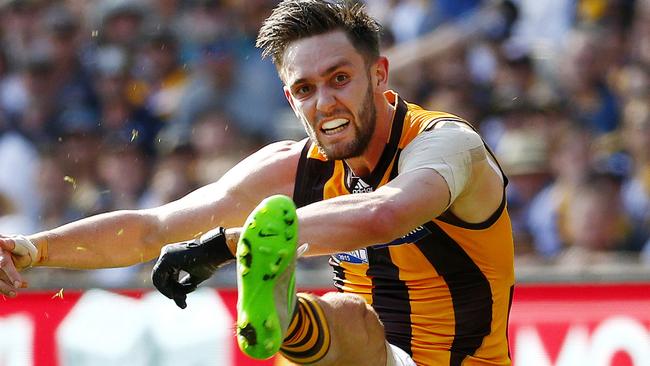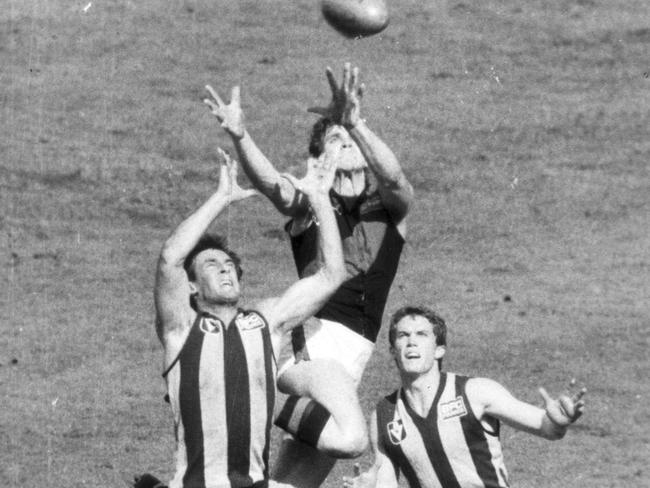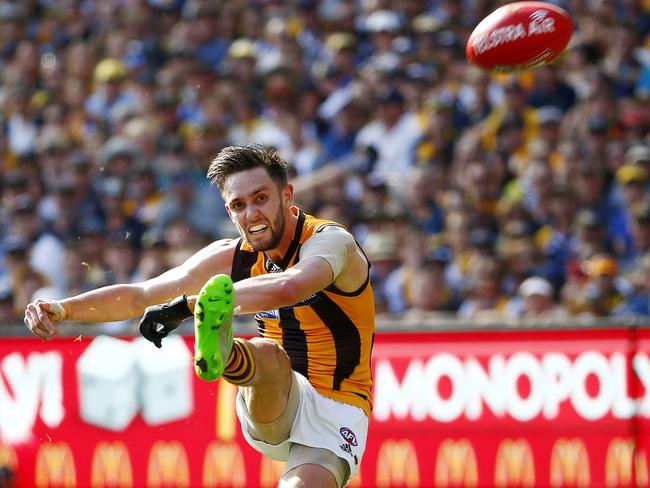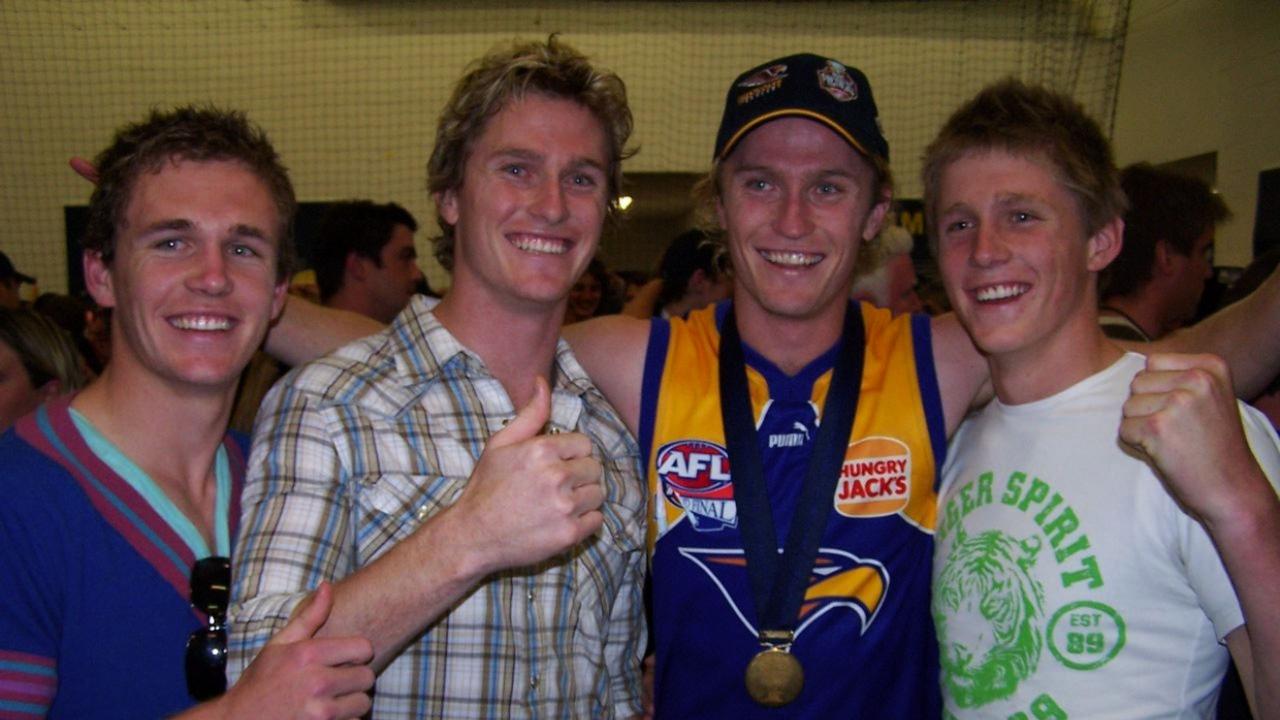AFL still making big dollars but game itself worse than in 1980s
YOU have to marvel at Hawthorn’s skills but footy just isn’t as fun to watch as it was in the bash and crash days of the 1980s, writes Richard Hinds.

Expert Opinion
Don't miss out on the headlines from Expert Opinion. Followed categories will be added to My News.
UPON entering a stadium the fans of most sports typically head for their moulded plastic seats, the merchandise stalls or the beer queue.
When AFL fans walk into a game they genuflect.
You don’t pay the inflated ticket price or take out the personal loan required to buy a hamburger at any sports venue without having a genuine belief in the “product’’ – as our games are now classified.
But indoctrinated in their parochial cities, emboldened by their code’s sustained growth and relentlessly bombarded by friendly media propaganda, the AFL fan is particularly fanatical in his conviction.
The AFL administration has been rightly praised over two decades for taking a stranglehold on the Australian sporting landscape.
The initiation of a truly national competition, the maximisation of revenue from media rights, sponsorship, membership and ticket sales and the acquisition of government funds to build stadiums and training venues have been lauded — and imitated — by rival codes.
The AFL was able to work this financial magic because it had a large, fanatical support base whose utter conviction about the game could be leveraged — some might say exploited.
Yet, as the AFL enters another season, an awkward question lingers: Is the actual game of Australian rules — as opposed to the product — as good as it was?
During the off-season the AFL-devoted Fox Footy channel filled the void with old games. Strikingly, it was the spirited encounters from previous decades — particularly the 1980s — that were most compelling.
Comparisons with “the day’’ can be skewed by sentimentality and selective amnesia. But even those of us who appreciate the explosive fitness, strength and (mostly) superior skills of the modern AFL player could not help thinking the game was at its peak 30 years ago.

The great irony of the modern AFL is that a game that prides itself as being Aussie-made has been compromised by its exposure to global sport. Zoning, interchange and tempo-football are the AFL’s European rabbits. The imports that suck the life from the local fauna.
Shifts and trends can be imperceptible. But their impact is stark when you watch old matches. When you see the soaring pack marks that were once the game’s greatest selling point and consider how players are no longer permitted to kick to contests.
When you see the crowd run onto the ground to celebrate a glamorous full-forward’s 100th goal, and remember that feat has only been achieved once (Lance Franklin’s 102 goals in 2008) in the past 17 years.
Yes the ball now moves rapidly up and down the ground. The coast-to-coast goal from a kick-in can be thrilling and the rapier kicking of triple premiers Hawthorn is unprecedented.
But the glut of uncontested possession and heavily congested mauls that have replaced the one-on-one duels between lightning wingers or hulking forwards and defenders are the heavy price of imported tactics.
The AFL’s latest response is the reduction in interchanges from 120 to 90 rotations. All sorts of zones with accompanying field markings have also been suggested to reduce ugly packs.
The AFL purists recoil at these suggestions crying: “Leave the game alone!’’ But they only need watch Essendon and Hawthorn fight out one of their thrilling finals in the mid-1980s to understand the game has been changed by stealth.

Aesthetics are not the AFL’s only challenge entering a new season. There is also their version of the old tree-in-a-forest conundrum: If GWS and Gold Coast win a game does it make a sound?
The Giants look primed this season. Talented kids have matured and seasoned recruits are providing leadership and character. Finals are a distinct possibility.
Yet despite the Giants’ insistence their gradual growth in the west is genuine, critics whisper the club’s membership figures are rubbery, free tickets are passed out like fast-food flyers and sponsorships look surprisingly similar to those already on the AFL books.
Whether this is scurrilous death-riding or genuine concern, five seasons into a proposed 20-year, $200 million build, already hard questions are being asked.
Then there is the spectre of Essendon.
For a season the AFL will be stuck with a team that will be an uncompetitive millstone and unfairly skew the draw in favour of those teams who play the Bombers twice.
The Essendon saga exposed the AFL’s embarrassing attempts at brand protection. Just as the failure to properly support Adam Goodes against racial vilification made hollow the league’s much trumpeted commitment to indigenous issues.
Even allowing for a belated apology to Goodes, the impression grows that the AFL is a cause merchant happily taking money to promote ideals, yet caught in the headlights when challenged to live by them.
It takes a lot to rock the faith of the AFL fan. But as healthy as the league remains, not all is well in the Temple of Sherrin.
Originally published as AFL still making big dollars but game itself worse than in 1980s


